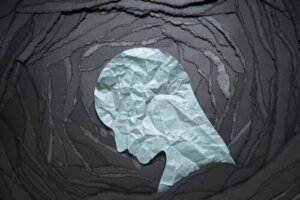What Are the Thoughts of Someone with Obsessive-Compulsive Disorder?

Thoughts in obsessive-compulsive disorder are constantly repeated. There’s a connection between the person and their own internal events that makes them value them in an exaggerated way. Therefore, they try to eliminate them from reality when they don’t exist.
Obsessive-compulsive disorder means that a person has obsessions that may take the form of images, thoughts, or impulses. Of course, the obsessions are tremendously annoying for the person who has them. They cause them extreme anxiety and discomfort. In order to neutralize these sensations or to stop the possible threat generated by the obsession, the person carries out compulsions.
Compulsions are acts, either motor or cognitive. In the short term, they manage to relieve the storm of aversive thoughts and sensations. As a result, the issue is that they’re precisely the maintainers of the problem due to negative reinforcement.
When a patient with obsessive-compulsive disorder acts out a compulsion, they’re basically telling themselves that the horror that the obsession warned him hasn’t occurred because he’s done something to prevent it (the compulsion). In other words, the compulsion gives the patient a false sense of control. Because of this, they’ll repeat the same pattern in future situations.
Obviously, compulsion is the area that therapists mostly work on with patients. At the same time, it’s also important to talk about the types of obsessions or thoughts in obsessive-compulsive disorder.
One of the problems in treatment is that the patients tend to merge with their own obsessions. This means that they actually believe that the thoughts are realities and that they’re their thoughts. They may even think that if they’re thinking about something it’s because it’s going to happen.

Thoughts in obsessive-compulsive disorder
The patient with obsessive-compulsive disorder tends to overvalue responsibility. They learn this through maladaptive beliefs that they acquire in childhood or form as a result of traumatic experiences or unusual circumstances.
These are dysfunctional beliefs that focus on blame or responsibility for an outcome. Some of these thinking errors are those proposed by Rachman (2003):
- Probabilistic action thought fusion. The belief that having an unwanted or unacceptable thought about a specific action or event increases the likelihood of that event occurring. For example, a patient believes that, by thinking about his brother’s death, it’s more likely to occur. In this way, the patient tries very hard to get this idea out of his head to avoid being responsible for any harm. However, you already know that running away from thoughts only increases them.
- Moral thought-action fusion. This is the belief that having an unacceptable thought is almost the moral equivalent of performing that particular act. For instance, if you think that you’re going to harm someone, it’s the same as committing that aggression.
- Cartesian reasoning. This is a very common way of thinking about obsessive-compulsive disorder. It means that the mere appearance of a thought is a sign of its importance. In other words, these patients place an inordinate value on having certain thoughts.
Other characteristics related to thoughts in obsessive-compulsive disorder are overestimation of threat, intolerance of uncertainty as an extreme need for certainty, and perfectionism.
Some recommendations for dealing with thoughts in OCD
The goal of psychological treatment for thoughts in obsessive-compulsive disorder is that the patient accepts that they have them. In addition, it doesn’t give them any kind of judgment and acts simply as a “spectator”.
To achieve this goal, it’s necessary to use some techniques:
- Delaying and, if possible, avoiding compulsion. Exposure with response prevention (ERP) is the treatment of choice for obsessive-compulsive disorder. The only drawback is that it has a high rate of premature abandonment. This is due to the fact that the patient has to endure large doses of anxiety response (ERP), which is the treatment of choice for obsessive-compulsive disorder. The only drawback is its high rate of premature abandonment because the patient has to be willing to endure large doses of anxiety until their actions are habitual.
ERP is effective in stopping OCD rituals, but it also acts on obsessions and has proven that they are reduced by a high percentage. To do this, the patient can start by delaying the compulsion for fifteen minutes and increasing the time.
After treatment, you’ll move on to avoid carrying out the compulsion, although the obsession remains. The obsession will then progressively lose power.

Thoughts in obsessive-compulsive disorder
- Be aware that we all have thoughts. Everyone, OCD or not, has impure, eccentric, and painful thoughts, just as everyone dreams at night. The problem with thoughts in OCD is that the person gives them real value and comes to believe them, feeling responsible for doing some harm.
- Thoughts aren’t realities. Patients have to make the effort to prove that thoughts aren’t realities. Thought is an internal event that has little or nothing to do with the external world. People can conduct experiments. For example, you can ask the person who thinks they’re going to win the lottery to buy a ticket. This way, we verify that thinking something has no relation to reality. At best, it’s in the form of chance.
Acceptance and commitment
- Cognitive defusion. This is an original term from acceptance and commitment therapy. It means to put everything in its place, “I’m me and my thoughts are something other than me. Just as if I’m diabetic, I’m not my diabetes. My thoughts don’t define me either”.
- Life is uncertain. OCD patients have to learn to live in uncertainty because life truly is uncertain.
- Anxiety alone is unpleasant. In a culture that has taught us that discomfort is intolerable, it’s normal for there to be people who believe they can’t bear certain thoughts or sensations. The reality is that the human being is prepared to bear all emotions and that, in most cases, these are necessary. We have to conceptualize anxiety as an unpleasant but allied emotion, not as an intolerable element we have to escape from.
Even so, the treatment of thoughts in obsessive-compulsive disorder is a great challenge, both for the patient and for the professional. It requires a great deal of support from the environment and a great deal of consistency in the tasks inside and outside the session. With time and hard work, results will gradually appear.
Thoughts in obsessive-compulsive disorder are constantly repeated. There’s a connection between the person and their own internal events that makes them value them in an exaggerated way. Therefore, they try to eliminate them from reality when they don’t exist.
Obsessive-compulsive disorder means that a person has obsessions that may take the form of images, thoughts, or impulses. Of course, the obsessions are tremendously annoying for the person who has them. They cause them extreme anxiety and discomfort. In order to neutralize these sensations or to stop the possible threat generated by the obsession, the person carries out compulsions.
Compulsions are acts, either motor or cognitive. In the short term, they manage to relieve the storm of aversive thoughts and sensations. As a result, the issue is that they’re precisely the maintainers of the problem due to negative reinforcement.
When a patient with obsessive-compulsive disorder acts out a compulsion, they’re basically telling themselves that the horror that the obsession warned him hasn’t occurred because he’s done something to prevent it (the compulsion). In other words, the compulsion gives the patient a false sense of control. Because of this, they’ll repeat the same pattern in future situations.
Obviously, compulsion is the area that therapists mostly work on with patients. At the same time, it’s also important to talk about the types of obsessions or thoughts in obsessive-compulsive disorder.
One of the problems in treatment is that the patients tend to merge with their own obsessions. This means that they actually believe that the thoughts are realities and that they’re their thoughts. They may even think that if they’re thinking about something it’s because it’s going to happen.

Thoughts in obsessive-compulsive disorder
The patient with obsessive-compulsive disorder tends to overvalue responsibility. They learn this through maladaptive beliefs that they acquire in childhood or form as a result of traumatic experiences or unusual circumstances.
These are dysfunctional beliefs that focus on blame or responsibility for an outcome. Some of these thinking errors are those proposed by Rachman (2003):
- Probabilistic action thought fusion. The belief that having an unwanted or unacceptable thought about a specific action or event increases the likelihood of that event occurring. For example, a patient believes that, by thinking about his brother’s death, it’s more likely to occur. In this way, the patient tries very hard to get this idea out of his head to avoid being responsible for any harm. However, you already know that running away from thoughts only increases them.
- Moral thought-action fusion. This is the belief that having an unacceptable thought is almost the moral equivalent of performing that particular act. For instance, if you think that you’re going to harm someone, it’s the same as committing that aggression.
- Cartesian reasoning. This is a very common way of thinking about obsessive-compulsive disorder. It means that the mere appearance of a thought is a sign of its importance. In other words, these patients place an inordinate value on having certain thoughts.
Other characteristics related to thoughts in obsessive-compulsive disorder are overestimation of threat, intolerance of uncertainty as an extreme need for certainty, and perfectionism.
Some recommendations for dealing with thoughts in OCD
The goal of psychological treatment for thoughts in obsessive-compulsive disorder is that the patient accepts that they have them. In addition, it doesn’t give them any kind of judgment and acts simply as a “spectator”.
To achieve this goal, it’s necessary to use some techniques:
- Delaying and, if possible, avoiding compulsion. Exposure with response prevention (ERP) is the treatment of choice for obsessive-compulsive disorder. The only drawback is that it has a high rate of premature abandonment. This is due to the fact that the patient has to endure large doses of anxiety response (ERP), which is the treatment of choice for obsessive-compulsive disorder. The only drawback is its high rate of premature abandonment because the patient has to be willing to endure large doses of anxiety until their actions are habitual.
ERP is effective in stopping OCD rituals, but it also acts on obsessions and has proven that they are reduced by a high percentage. To do this, the patient can start by delaying the compulsion for fifteen minutes and increasing the time.
After treatment, you’ll move on to avoid carrying out the compulsion, although the obsession remains. The obsession will then progressively lose power.

Thoughts in obsessive-compulsive disorder
- Be aware that we all have thoughts. Everyone, OCD or not, has impure, eccentric, and painful thoughts, just as everyone dreams at night. The problem with thoughts in OCD is that the person gives them real value and comes to believe them, feeling responsible for doing some harm.
- Thoughts aren’t realities. Patients have to make the effort to prove that thoughts aren’t realities. Thought is an internal event that has little or nothing to do with the external world. People can conduct experiments. For example, you can ask the person who thinks they’re going to win the lottery to buy a ticket. This way, we verify that thinking something has no relation to reality. At best, it’s in the form of chance.
Acceptance and commitment
- Cognitive defusion. This is an original term from acceptance and commitment therapy. It means to put everything in its place, “I’m me and my thoughts are something other than me. Just as if I’m diabetic, I’m not my diabetes. My thoughts don’t define me either”.
- Life is uncertain. OCD patients have to learn to live in uncertainty because life truly is uncertain.
- Anxiety alone is unpleasant. In a culture that has taught us that discomfort is intolerable, it’s normal for there to be people who believe they can’t bear certain thoughts or sensations. The reality is that the human being is prepared to bear all emotions and that, in most cases, these are necessary. We have to conceptualize anxiety as an unpleasant but allied emotion, not as an intolerable element we have to escape from.
Even so, the treatment of thoughts in obsessive-compulsive disorder is a great challenge, both for the patient and for the professional. It requires a great deal of support from the environment and a great deal of consistency in the tasks inside and outside the session. With time and hard work, results will gradually appear.
All cited sources were thoroughly reviewed by our team to ensure their quality, reliability, currency, and validity. The bibliography of this article was considered reliable and of academic or scientific accuracy.
- Caballo, V. (2014). Manual de psicopatología y trastornos psicológicos. Editorial Pirámide. 2º edición
This text is provided for informational purposes only and does not replace consultation with a professional. If in doubt, consult your specialist.







